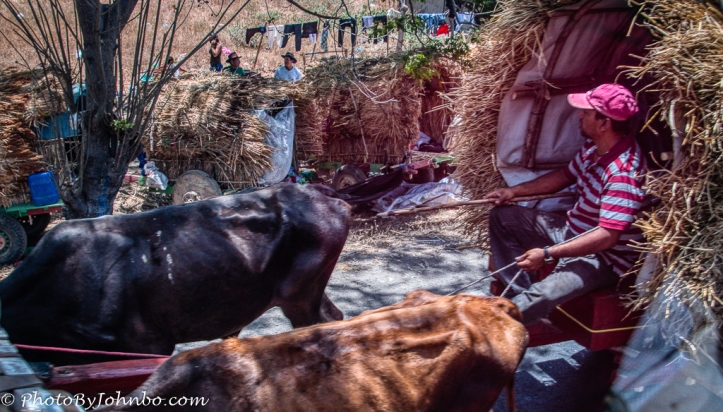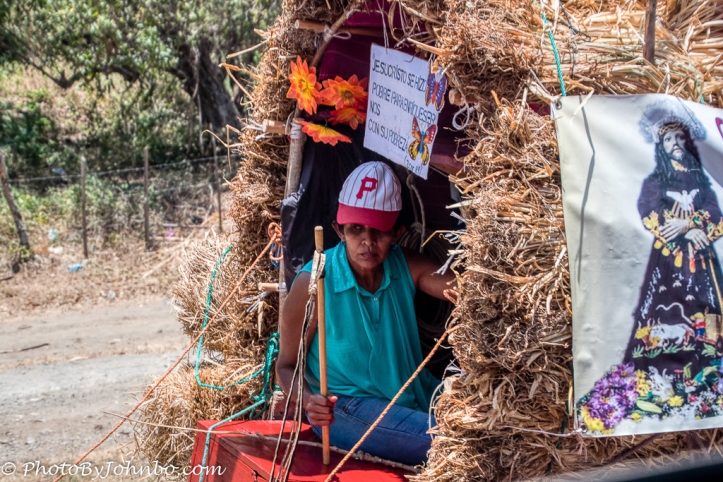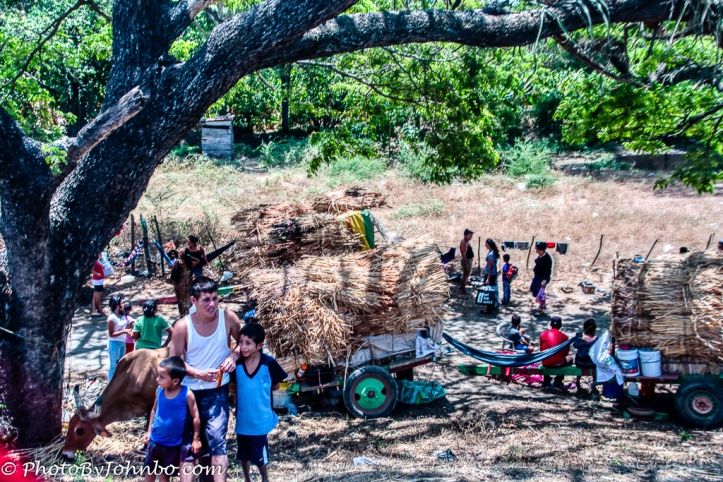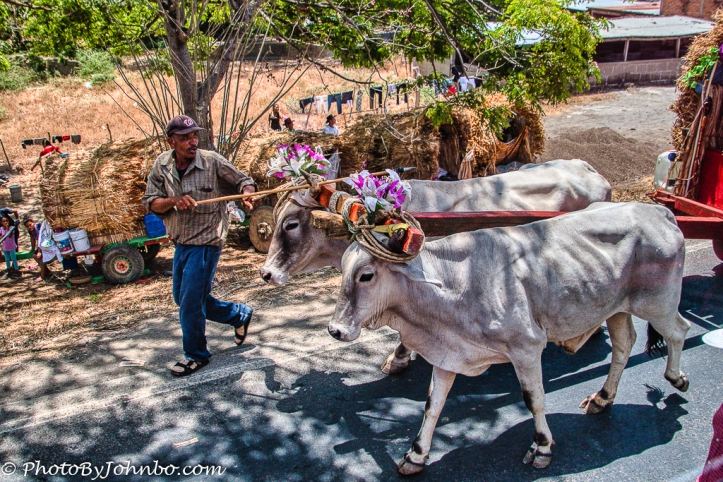It’s a long bus ride from the port city of San Juan Del Sur to Masaya Volcano. A couple of weeks ago, I shared photos of our visit to the volcano noting that there was about a 30-minute delay as we sat in stopped traffic. The tour guide wasn’t sure, but he guessed correctly that the delay was due to the passing of the pilgrimage, an annual holy week tradition some 150 years old. We couldn’t quite figure out how the traffic delay worked but we were sitting on the northbound lane in stopped traffic not moving at all, yet traffic appeared to be moving just fine in the southbound lane. At first I thought the single lane traffic would stop in the southbound lane and then we would proceed. It didn’t exactly happen that way.
 Eventually the cause of our delay passed in the southbound lane. A long line of ox and pony carts traveled single-file past our bus window. Much as I would have liked to have the freedom of movement to capture the event from different angles, I was stuck on the bus. Fortunately my seat happened to be on the correct side of the bus so that I had a clear view out the window of the procession as it moved along the highway.
Eventually the cause of our delay passed in the southbound lane. A long line of ox and pony carts traveled single-file past our bus window. Much as I would have liked to have the freedom of movement to capture the event from different angles, I was stuck on the bus. Fortunately my seat happened to be on the correct side of the bus so that I had a clear view out the window of the procession as it moved along the highway.
 When we returned home, I was able to find out more about the pilgrimage. The Internet can be a wonderful thing. In the days before Holy Week, the faithful who will be participating in the centuries-old event gather in Nandaime to prepare for the journey to Popoyuapa. Their goal is to honor Jesus the Rescuer, their devotion in thankfulness for the miracles given them in their lifetime. To these faithful Christians, the pilgrimage is one of the most important religious experiences in the country of Nicaragua.
When we returned home, I was able to find out more about the pilgrimage. The Internet can be a wonderful thing. In the days before Holy Week, the faithful who will be participating in the centuries-old event gather in Nandaime to prepare for the journey to Popoyuapa. Their goal is to honor Jesus the Rescuer, their devotion in thankfulness for the miracles given them in their lifetime. To these faithful Christians, the pilgrimage is one of the most important religious experiences in the country of Nicaragua.
 Carts contain the traveling gear, food, and other necessities for the week-long pilgrimage. Covered with palm and other plants to help keep the interior cool, they are decorated in colors important to the season; purple in recognition of Holy Week, yellow, representing the Catholic Church, and blue representing Nicaragua. As they passed by, I couldn’t help but think about the sacrifices the pilgrims make having to acquire oxen, care for them, build or buy a cart, outfit the family for the trip and take off work to make the pilgrimage.
Carts contain the traveling gear, food, and other necessities for the week-long pilgrimage. Covered with palm and other plants to help keep the interior cool, they are decorated in colors important to the season; purple in recognition of Holy Week, yellow, representing the Catholic Church, and blue representing Nicaragua. As they passed by, I couldn’t help but think about the sacrifices the pilgrims make having to acquire oxen, care for them, build or buy a cart, outfit the family for the trip and take off work to make the pilgrimage.
 Hanging from many of the carts were lawn chairs, food baskets, and many other necessities for a trip such as this. From my research, I found that the journey takes some pilgrims as many as four days, and the journey may be as long as 75 miles (120 km) each way. Some apparently walk at night and rest during the hot days. Others walk day and night. In 2013, according to one article I read, over 400 carts arrived in Popoyuapa at the feet of the statue of Jesus del Rescate.
Hanging from many of the carts were lawn chairs, food baskets, and many other necessities for a trip such as this. From my research, I found that the journey takes some pilgrims as many as four days, and the journey may be as long as 75 miles (120 km) each way. Some apparently walk at night and rest during the hot days. Others walk day and night. In 2013, according to one article I read, over 400 carts arrived in Popoyuapa at the feet of the statue of Jesus del Rescate.
 Upon our return from the volcano park, we found that many of the pilgrims had made camp and were either calling it a day or maybe just waiting for the heat of the day to pass so that they could continue in the cooler night air. The tradition, I’m told, went back over 400 years, however the oxcart procession began in the mid-1800’s. I submit for your review images I captured of the pilgrimage from our admittedly limited viewpoint out of a bus window. You may click on an image to enlarge it and to scroll through the gallery.
Upon our return from the volcano park, we found that many of the pilgrims had made camp and were either calling it a day or maybe just waiting for the heat of the day to pass so that they could continue in the cooler night air. The tradition, I’m told, went back over 400 years, however the oxcart procession began in the mid-1800’s. I submit for your review images I captured of the pilgrimage from our admittedly limited viewpoint out of a bus window. You may click on an image to enlarge it and to scroll through the gallery.
John Steiner












What a cool thing to have had the opportunity to see! All that world traveling you’re becoming a very worldly dude!
I am looking forward to more travel in new continents next year!
[…] On the ship and on our excursions, we saw many others living their own special moments. During the holy week before Easter, we were in Nicaragua on our way to visit an active volcano. At one point, we were stopped in traffic for over 30 minutes while we awaited a pilgrimage to pass us. An annual event for over 150 years, a group of faithful in Nicaragua travel many days by oxcart to Popoyuapa to celebrate on Easter Sunday. More about the pilgrimage and photos can be found here. […]